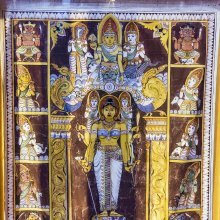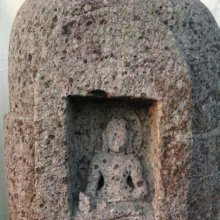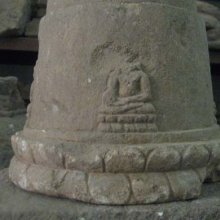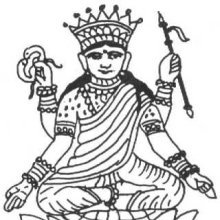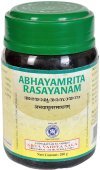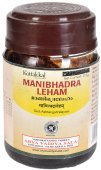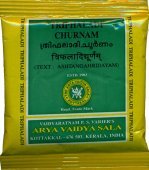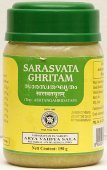Abhaya, Abhayā: 48 definitions
Introduction:
Abhaya means something in Buddhism, Pali, Hinduism, Sanskrit, the history of ancient India, Marathi, Jainism, Prakrit, Hindi, biology. If you want to know the exact meaning, history, etymology or English translation of this term then check out the descriptions on this page. Add your comment or reference to a book if you want to contribute to this summary article.
Alternative spellings of this word include Abhay.
Images (photo gallery)
(+108 more images available)
In Hinduism
Ayurveda (science of life)
Cikitsa (natural therapy and treatment for medical conditions)
Source: Ancient Science of Life: Botanical identification of plants described in Mādhava CikitsāAbhayā (अभया) (or Harītakī, Pathyā) (one of the Triphala) refers to the medicinal plant Terminalia chebula Retz., and is used in the treatment of atisāra (diarrhoea), according to the 7th century Mādhavacikitsā chapter 2. Atisāra refers to a condition where there are three or more loose or liquid stools (bowel movements) per day or more stool than normal. The second chapter of the Mādhavacikitsā explains several preparations [including Abhayā] through 60 Sanskrit verses about treating this problem.
Kalpa (Formulas, Drug prescriptions and other Medicinal preparations)
Source: Wisdom Library: Ayurveda / KalpaAbhayā (अभया) is the name of a Kalpa (formulation/therapy) dealt with in a section [=abhayākalpaḥ] of the Gaurīkāñcalikātantra (i.e., “Gauri Kanchalika Tantra”): an ancient Sanskrit Shaiva Tantra framed as a dialogue between the God (Śiva) and the Goddess (Śivā). The text deals with spiritual and medical herbalism such as the treatment of fever and diseases in the form of Kalpas, commonly known in Āyurveda as “remedies” or “antidotes”. The Gaurīkāñcalikā-tantra further deals with a variety of harvesting techniques and rules for optimal efficiency in collecting herbs while respecting and preserving the natural environment.
Source: Shodhganga: Edition translation and critical study of yogasarasamgrahaAbhayā (अभया) refers to the medicinal plant known as “Terminalia chebula Retz.” and is dealt with in the 15th-century Yogasārasaṅgraha (Yogasara-saṅgraha) by Vāsudeva: an unpublished Keralite work representing an Ayurvedic compendium of medicinal recipes. The Yogasārasaṃgraha [mentioning abhayā] deals with entire recipes in the route of administration, and thus deals with the knowledge of pharmacy (bhaiṣajya-kalpanā) which is a branch of pharmacology (dravyaguṇa).
Toxicology (Study and Treatment of poison)
Source: Shodhganga: Kasyapa Samhita—Text on Visha ChikitsaAbhayā (अभया) is the name of an ingredient used in the treatment of rat-poison such as those caused by the Krūra-rats, according to the Kāśyapa Saṃhitā: an ancient Sanskrit text from the Pāñcarātra tradition dealing with both Tantra and Viṣacikitsā—an important topic from Āyurveda which deals with the study of Toxicology (Viṣavidyā or Sarpavidyā).—Accordingly, one of the treatments is mentioned as follows: “A paste of Punarnāva and Abhayā, made with buttermilk, is to be drunk and the same is to be applied as lepa. Fumigation must be carried out with Abhayā and jaggery. Lunch must be had with buttermilk”.
Agriculture (Krishi) and Vrikshayurveda (study of Plant life)
Source: Shodhganga: Drumavichitrikarnam—Plant mutagenesis in ancient IndiaAbhaya (अभय) (identified with Terminalia chebula) is used in various bio-organical recipes for plant mutagenesis such as changing plants into creepers, according to the Vṛkṣāyurveda by Sūrapāla (1000 CE): an encyclopedic work dealing with the study of trees and the principles of ancient Indian agriculture.—Accordingly, “A seed of the Limonia acidissima should be cultured hundred times with milk boiled along with the roots of Emblica officinalis, Acorus calamus, Terminalia chebula [e.g., Abhaya], Aspota (?), Aśmapāna (?), Calamus rotang, Dalbergia sissoo, Leptadenia reticulata, Hiptage benghalensis and Butea superba for over a month and then should be sown in a pit keeping in water mixed with clarified butter, and flesh of the boar. Thereafter, the pit should be filled with good quality soil measuring four fingers in thickness and then it should be watered with the decoction of Hordeum vulgare, Vigna mungo, Sesamum indicum, honey, fish and flesh. The seed then grows into a creeper without fail”.
Unclassified Ayurveda definitions
Source: Wisdom Library: Āyurveda and botanyAbhayā (अभया):—One of the seven varieties of Harītakī (‘yellow myrobalan tree’), a tree from the Combretaceae family, which is used throughout Ayurvedic literature such as the Caraka-saṃhitā. It is available throughout Champa (Bhagalpur area). Its official botanical name is Terminalia chebula and is commonly known in English as “chebulic myrobalan”. It has nut-like fleshy fruits, the seed of which is used in Āyurveda and Tibetan medicine as a universal panacea (remedy). The word Abhayā is derived from the Sanskrit abhaya, literally translating to “fearless, not dangerous, secure”
Source: archive.org: Sushruta samhita, Volume IThe Abhayā (Chebulic Myrobalans) proves curative in cases of ulcers, is heat-making (in its potency), and acts as a purgative, tends to reduce corpulency and subdues the deranged humours. It is appetising and invigorating to the eye-sight, has an acid and astringent taste, and proves curative in œdema and cutaneous affections.

Āyurveda (आयुर्वेद, ayurveda) is a branch of Indian science dealing with medicine, herbalism, taxology, anatomy, surgery, alchemy and related topics. Traditional practice of Āyurveda in ancient India dates back to at least the first millenium BC. Literature is commonly written in Sanskrit using various poetic metres.
Purana and Itihasa (epic history)
Source: archive.org: Puranic EncyclopediaAbhaya (अभय) was one of the sons of Dhṛtarāṣṭra. He was killed by Bhīmasena. (Mahābhārata Ādi Parva, Chapter 67, Verse 104; Droṇa Parva, Chapter 127, Verse 62).
Source: archive.org: Shiva Purana - English TranslationAbhaya (अभय) refers to the “abode of safety” which is mentioned as being held in one of the hands (hasta) of the Goddess (Devī), according to the Śivapurāṇa 2.2.12. Accordingly as Brahmā narrated to Nārada:—“[...] on seeing the mother of the universe cosmic in form, Dakṣa the lord of the subjects considered himself well rewarded. With various sorts of prayer he eulogised and bowed to the Goddess (Devī) mother of the universe, Kālikā seated on a lion, dark-complexioned, with four arms (caturbhuja) and beautiful face, the bestower of the boon, the abode of safety (abhaya), holding a blue lotus and the sword in her hands (hasta), comely with reddish eyes and with beautiful dishevelled hair”.
Source: Cologne Digital Sanskrit Dictionaries: The Purana Index1a) Abhaya (अभय).—Son of Dharma and Dayā: a sage.*
- * Bhāgavata-purāṇa IV. 1. 50; Matsya-purāṇa 198. 3.
1b) One of the seven continents of Plakṣadvīpa. (Jambūdvīpa—Burnouf).*
- * Bhāgavata-purāṇa V. 20. 3.
1c) A R. of Krauñcadvīpa.*
- * Bhāgavata-purāṇa V. 20. 21.
2) Abhayā (अभया).—The goddess enshrined in Uṣṇatīrtha.*
- * Matsya-purāṇa 13. 42.
Abhaya (अभय) is a name mentioned in the Mahābhārata (cf. I.108.12) and represents one of the many proper names used for people and places. Note: The Mahābhārata (mentioning Abhaya) is a Sanskrit epic poem consisting of 100,000 ślokas (metrical verses) and is over 2000 years old.

The Purana (पुराण, purāṇas) refers to Sanskrit literature preserving ancient India’s vast cultural history, including historical legends, religious ceremonies, various arts and sciences. The eighteen mahapuranas total over 400,000 shlokas (metrical couplets) and date to at least several centuries BCE.
Vastushastra (architecture)
Source: Wisdom Library: Vāstu-śāstraAbhaya (अभय, “absence of fear”) refers to the seventh of nine aṃśa (part), according to the Mānasāra. Aṃśa is the alternative sixth of the āyādiṣaḍvarga, or “six principles” that constitute the “horoscope” of an architectural or iconographic object. Their application is intended to “verify” the measurements of the architectural and iconographic object against the dictates of astrology that lay out the conditions of auspiciousness.
The particular aṃśa (e.g., abhaya) of all architectural and iconographic objects (settlement, building, image) must be calculated and ascertained. This process is based on the principle of the remainder. An arithmetical formula to be used in each case is stipulated, which engages one of the basic dimensions of the object (breadth, length, or perimeter/circumference). Among the nine taskara, the ones named ṣaṇḍa and vipat are inauspicious, and should therefore be avoided.

Vastushastra (वास्तुशास्त्र, vāstuśāstra) refers to the ancient Indian science (shastra) of architecture (vastu), dealing with topics such architecture, sculpture, town-building, fort building and various other constructions. Vastu also deals with the philosophy of the architectural relation with the cosmic universe.
Shilpashastra (iconography)
Source: Shodhganga: The significance of the mūla-beras (śilpa)1) Abhaya (अभय) represents “peraruludaimai” (benevolence), referring to one of the attributes of Lord Śiva, commonly seen depicted in Hindu iconography, defined according to texts dealing with śilpa (arts and crafs), known as śilpaśāstras.—The śilpa texts have classified the various accessories under the broad heading of āyudha or karuvi (implement), including even flowers, animals, and musical instruments. The accessories should be made of the same material with which the main image has been fashioned. Each of these accessories denotes the attributes of the images while in certain circumstances they denote particular divinity or character by themselves. Abhaya, for example, signifies the attributes of Lord Śiva.
2) Abhaya (अभय) or Abhayahasta refers to “fear not” and represents one of the twenty-four gestures with a single hand, as defined according to texts dealing with śilpa (arts and crafs), known as śilpaśāstras.—Accordingly, pratimā-lakṣaṇa (body postures of the icons) is comprised of hand gestures (hasta, mudrā or kai-amaiti), stances/poses (āsanas) and inflexions of the body (bhaṅgas). There are thirty-two types of hands [viz., abhaya-hasta] classified into two major groups known as tolirkai (functional and expressive gestures) and elirkai (graceful posture of the hand).

Shilpashastra (शिल्पशास्त्र, śilpaśāstra) represents the ancient Indian science (shastra) of creative arts (shilpa) such as sculpture, iconography and painting. Closely related to Vastushastra (architecture), they often share the same literature.
Kavya (poetry)
Source: OpenEdition books: Vividhatīrthakalpaḥ (Kāvya)Abhayā (अभया) is the name of a queen who fell in love with Sudarśana, as mentioned in the Vividhatīrthakalpa by Jinaprabhasūri (13th century A.D.): an ancient text devoted to various Jaina holy places (tīrthas).—Accordingly, “In love with Sudarśana, Queen Abhayā, weary of her vain advances, has her forced to the castle by her maids. There, she takes revenge for her stubborn refusal by slandering him to King Dadhivāhana, her husband. But, a golden Yakṣa, attracted by his wife's recollection, intervenes and saves her, changing the sword of justice into a garland of flowers”.
Cf. Āvaśyakacūrṇi II 270.13-271.3; Āvasyakaniryukti (Haribhadra commentary) b.6-a.2.

Kavya (काव्य, kavya) refers to Sanskrit poetry, a popular ancient Indian tradition of literature. There have been many Sanskrit poets over the ages, hailing from ancient India and beyond. This topic includes mahakavya, or ‘epic poetry’ and natya, or ‘dramatic poetry’.
Jyotisha (astronomy and astrology)
Source: Wisdom Library: Brihat Samhita by VarahamihiraAbhaya (अभय) refers to “freedom from fear”, according to the Bṛhatsaṃhitā (chapter 5), an encyclopedic Sanskrit work written by Varāhamihira mainly focusing on the science of ancient Indian astronomy astronomy (Jyotiṣa).—Accordingly, “[...] Commencing from the time of creation, ... Varuṇa is the lord over the new and full moon periods of the fifth six months; Agni over those of the sixth six months and Yama over those of the seventh six months; [...] If Varuṇa should be the lord, princes will suffer; the rest will be happy and crops will flourish. If Agni should be the lord, there will be good crops, and there will also be health, freedom from fear [i.e., abhaya] and abundance of water. If Yama should be the lord, there will be drought, famine, and total blight of crops; in the next parva mankind will be afflicted with misery, hunger, death and drought”.
Source: Google Books: Studies in the History of the Exact Sciences (Astronomy)Abhaya (अभय) refers to the “safety” (of the couple), according to the Nāradasaṃhitā verse 29.86-95 (pp. 181-184), a Sanskrit work on astrology having the Saralā commentary by Vasatirāma Śarmā.—Accordingly, “[...] The best of the astrologers should measure that auspicious moment by means of the water clock. [...] With this formula, one should deposit the best of the instruments, endowed with the aforementioned characteristics: ‘You have been created a long time ago by Brahmā as the foremost among the [time measuring] instruments. For the safety (abhaya) of the couple, you become the means of measuring the time [of their wedding]’.”.

Jyotisha (ज्योतिष, jyotiṣa or jyotish) refers to ‘astronomy’ or “Vedic astrology” and represents the fifth of the six Vedangas (additional sciences to be studied along with the Vedas). Jyotisha concerns itself with the study and prediction of the movements of celestial bodies, in order to calculate the auspicious time for rituals and ceremonies.
Shaktism (Shakta philosophy)
Source: Brill: Śaivism and the Tantric Traditions (shaktism)Abhaya (अभय) (Cf. Abhīti) refers to “(the gesture of) protection”, according to the King Vatsarāja’s Pūjāstuti called the Kāmasiddhistuti (also Vāmakeśvarīstuti), guiding one through the worship of the Goddess Nityā.—Accordingly, “[...] I worship the three-eyed sharp-natured Kṣetreśa. His body is black, he has destroyed his adversaries, he carries a skull-bowl and a spear, [but] he is compassionate. I resort to Śaṅkhanidhi and Padmanidhi, who who sit upon a conch and lotus [respectively] as their seats. They are patient, bear the gestures of generosity and protection (abhaya-dhara) in their hands, and bring about everyone’s dreams. [...]

Shakta (शाक्त, śākta) or Shaktism (śāktism) represents a tradition of Hinduism where the Goddess (Devi) is revered and worshipped. Shakta literature includes a range of scriptures, including various Agamas and Tantras, although its roots may be traced back to the Vedas.
Shaivism (Shaiva philosophy)
Source: SOAS University of London: Protective Rites in the Netra TantraAbhaya (अभय) or Abhayapāṇika refers to the “hand positions of safety”, according to the Netratantra of Kṣemarāja: a Śaiva text from the 9th century in which Śiva (Bhairava) teaches Pārvatī topics such as metaphysics, cosmology, and soteriology.—Accordingly, [verse 3.17-23, while describing a meditation on Amṛteśa in his form as Mṛtyujit]—“And so now, having constructed the amṛtāmudrā or the padmamudrā, [the Mantrin] should meditate on the Ātman. [...] [He is] one-faced, three-eyed, seated on a white lotus, fixed in the bound lotus seat. [He is] four-armed, large-eyed, the hand [fixed in the position] of granting wishes and safety (abhaya-pāṇika—varadābhayapāṇikam), [holding] a full moon, radiant, filled with amṛta, holding a water pot, [and] completely full of the world, the moon in his lovely hand. [The Mantrin] should remember him adorned with a reverence that is all white”.

Shaiva (शैव, śaiva) or Shaivism (śaivism) represents a tradition of Hinduism worshiping Shiva as the supreme being. Closely related to Shaktism, Shaiva literature includes a range of scriptures, including Tantras, while the root of this tradition may be traced back to the ancient Vedas.
Sports, Arts and Entertainment (wordly enjoyments)
Source: archive.org: Syainika Sastra of Rudradeva with English Translation (art)Abhayā (अभया) refers to “yellow myrobalan” (used in the treatment of Hawks), according to the Śyainika-śāstra: a Sanskrit treatise dealing with the divisions and benefits of Hunting and Hawking, written by Rājā Rudradeva (or Candradeva) in possibly the 13th century.—Accordingly, [while discussing the treatment of hawks]: “If a white spot forms on the eyes owing to heat, smoke or some kind of hurt, [...] Or a pill made of the following drugs in equal quantities, soaked in goat’s urine and dried in the shade, may be given ; turmeric, leaves of nīm/neem, pepper, yellow myrobalan (abhayā), long pepper, Cyperus rotundus, and viḍaṅga. It should be administered with honey and goat’s milk in the case of the red kind of birds. This pill destroys the spot, as if the pill had been made by Rudra”.

This section covers the skills and profiencies of the Kalas (“performing arts”) and Shastras (“sciences”) involving ancient Indian traditions of sports, games, arts, entertainment, love-making and other means of wordly enjoyments. Traditionally these topics were dealt with in Sanskrit treatises explaing the philosophy and the justification of enjoying the pleasures of the senses.
Pancaratra (worship of Nārāyaṇa)
Source: archive.org: Catalogue of Pancaratra Agama Texts1) Abhaya (अभय) or Abhayamudrā is the name of a Mudrā (“ritual hand-gestures”) mentioned in in chapter 13 of the Viśvāmitrasaṃhitā: a Pāñcarātra text comprising some 2600 Sanskrit verses covering topics such as initiation (dīkṣā) and the construction, decoration and consecration of temples and icons, as well as routines of regular and special worship cycles.—Description of the chapter [mudrā-adhyāya]: Kāśyapa asks what are the various types of mudrā-gestures, and Viśvāmitra complies by first defining mudrā as that by seeing which one derives pleasure (“mu-”) and then by counseling that whoever practices these mudrās must do so in secrecy (1-6). Thereupon he names and briefly describes how to perform a number of mudrās [e.g., abhaya]
2) Abhaya (अभय) or Abhayamudrā is the name of a Mudrā mentioned in chapter 4 of the Viṣṇutilakasaṃhitā: a Pāñcarātra text comprising 3500 Sanskrit verses covering the typically “agamic” subjects which are being narrated by Brahmā to a number of sages.—Description of the chapter [yoga-adhyāya]: [...] The namatraya-mantra (Acyuta, Ananta and Govinda) is then mentioned, as is the agniprākāra-mantra. This is followed by brief descriptions of mudrās [e.g., abhaya-mudrā]—which “please” Him (649-680).

Pancaratra (पाञ्चरात्र, pāñcarātra) represents a tradition of Hinduism where Narayana is revered and worshipped. Closeley related to Vaishnavism, the Pancaratra literature includes various Agamas and tantras incorporating many Vaishnava philosophies.
General definition (in Hinduism)
Source: Wisdom Library: HinduismAbhayā (अभया):—Sanskrit word which could stand for the Yellow myrobalan tree (Terminalia Chebula).
In Buddhism
Theravada (major branch of Buddhism)
Source: Pali Kanon: Pali Proper Names1. Abhaya Thera - An arahant. He was a Brahmin of Savatthi who, having heard the Buddha preach, entered the Order. One day, while going to the village for alms, he was disturbed in mind by an attractively dressed woman, but he recollected himself and developed insight (Thag.v.98; ThagA.i.201-2).
In a former birth he had met Sumedha Buddha in the forest and had offered him a wreath of salala flowers. Nineteen kappas ago he was born sixteen times as king, his name being Nimmita. He is probably to be identified with the Thera Vatamsakiya of the Apadana (i.174).
2. Abhaya - Commonly called Abhayarajakumara.
He was the son of King Bimbisara and of Padumavati, the belle of Ujjeni. When the boy was seven years old, his mother sent him to the king and he grew up with the boys of the court. He first came under the influence of the Nigantha Nataputta, who taught him a dilemma to set the Samana Gotama. In the Buddhas reply, the prince recognised the defeat of the Nigantha and the supreme Enlightenment of the Exalted One, whose disciple he then became. Later, when the king died, Abhaya was disturbed in mind, and entered the Order. On the occasion of the preaching of the Talacchiggalupama Sutta (probably the same as S.v.455 and M.iii.169), he became a Stream enterer and afterwards attained arahantship (Thag.26; ThagA.i.83-4 also ThagA.39. In ThagA. his mothers name does not appear). The Abhayarajakumara Sutta (M.i.392ff ) contains the dilemma episode. It also mentions that at the time the prince had a little son of whom he was evidently very fond.
In the Samyutta Nikaya (S.v.126-8) he is stated as having visited the Buddha at Gijjhakuta and discussed with him the views of Purana Kassapa. The Buddha teaches him about the seven bojjhangas.
In the Vinaya (i.269), Abhaya is mentioned as having discovered Jivaka Komarabhacca lying on a dung heap (cast there by the orders of his mother, the courtesan Salavati), and having brought him up.
The Anguttara Commentary (i.216), on the other hand, says that Abhaya was Jivakas natural father.
As a reward for quelling a disturbance on the frontier, Abhaya was given a skilled nautch girl by his father, Bimbisara. For seven days he enjoyed her company to the exclusion of all else, but on the seventh day she died. Disconsolate, he sought comfort from the Buddha, who assuaged his grief (DhA.iii.166-67; cf. the story of Santati).
The Apadana (ii.502-4) gives the story of his past. He had been a brahmin of Hamsavati, skilled in the Vedas; having heard the Buddha Padumuttara preach, he was converted and joined the Order, where he spent his time singing the greatness of the Buddha.
The Theragatha Commentary (i.83-4) quotes, in his story, some verses in the Apadana, which in the Apadana itself are ascribed to a Thera Ketakapupphiya.
-- or --
A Theri. Theravāda is a major branch of Buddhism having the the Pali canon (tipitaka) as their canonical literature, which includes the vinaya-pitaka (monastic rules), the sutta-pitaka (Buddhist sermons) and the abhidhamma-pitaka (philosophy and psychology).
Mahayana (major branch of Buddhism)
Source: Wisdom Library: Maha Prajnaparamita SastraAbhaya (अभय) is the son of king Bimbisāra and Āmrapāli according to the Sarvāstivādin Vinaya mentioned in a note at the 2nd century Mahāprajñāpāramitāśāstra (chapter XXVIII).—According to the Sarvāstivādin Vinaya, the son of Bimbisāra and Āmrapālī was called Abhaya (Gilgit Manuscripts, III, 2, p. 22), while Jīvaka was the son of Bimbisāra and the wife of a merchant whose name is not given. In the Pāli sources, Vimala-Kondañña is given as the son of Bimbisāra and Āmrapālī (Theragāthā Comm., I, p. 146): Jīvaka’s father was Abhaya-Rājakumāra—one of Bimbisāra’s sons—and his mother, a courtesan of Rājagṛha called Sālavati.
Source: archive.org: Bulletin of the French School of the Far East (volume 5)Abhaya (अभय) is the name of a Kinnara appointed as one of the Divine protector deities of Śūlīka, according to chapter 17 of the Candragarbha: the 55th section of the Mahāsaṃnipāta-sūtra, a large compilation of Sūtras (texts) in Mahāyāna Buddhism partly available in Sanskrit, Tibetan and Chinese.—In the Candragarbhasūtra, the Bhagavat invites all classes of Gods and Deities to protect the Law [dharma?] and the faithful in their respective kingdoms of Jambudvīpa [e.g., the Kinnara Abhaya in Śūlīka], resembling the time of the past Buddhas.
Source: academia.edu: A Study and Translation of the GaganagañjaparipṛcchāAbhaya (अभय) refers to “fearlessness”, according to the Gaganagañjaparipṛcchā: the eighth chapter of the Mahāsaṃnipāta (a collection of Mahāyāna Buddhist Sūtras).—Accordingly: “At that time, there were five hundred men who were in danger of being killed [by robbers]. When they were led to their death, a voice resonated in open space: ‘You should do homage to the Bodhisattva Gaganagañja, who provides fearlessness (abhaya) to the frightened. Then you will be saved from death’. Then all those, terrified with the fear of death, said together in one voice: ‘Homage to the Bodhisattva, the great being Gaganagañja!’ [...]”.

Mahayana (महायान, mahāyāna) is a major branch of Buddhism focusing on the path of a Bodhisattva (spiritual aspirants/ enlightened beings). Extant literature is vast and primarely composed in the Sanskrit language. There are many sūtras of which some of the earliest are the various Prajñāpāramitā sūtras.
Tibetan Buddhism (Vajrayana or tantric Buddhism)
Source: Wisdom Library: Tibetan Buddhism1) Abhayā (अभया) is the name of Vidyārājñī (i.e., “wisdom queen”) mentioned as attending the teachings in the 6th century Mañjuśrīmūlakalpa: one of the largest Kriyā Tantras devoted to Mañjuśrī (the Bodhisattva of wisdom) representing an encyclopedia of knowledge primarily concerned with ritualistic elements in Buddhism. The teachings in this text originate from Mañjuśrī and were taught to and by Buddha Śākyamuni in the presence of a large audience (including Abhayā).
2) Abhayā (अभया) is also the name of a Yakṣiṇī mentioned as attending the teachings in the 6th century Mañjuśrīmūlakalpa.

Tibetan Buddhism includes schools such as Nyingma, Kadampa, Kagyu and Gelug. Their primary canon of literature is divided in two broad categories: The Kangyur, which consists of Buddha’s words, and the Tengyur, which includes commentaries from various sources. Esotericism and tantra techniques (vajrayāna) are collected indepently.
India history and geography
Source: archive.org: Ceylon Branch of the Royal Asiatic Society 1963Abhaya is the name of a convent (monastary for bhikkuṇis) built by Mahāsena (275-301) in the Citadel (inner city) of Anurādhapura.—It is likely that the Abhaya and Uttara convents were in the Abhayagiri Entourage. The cital (inner city) of Anurādhapura was included in Paṇḍukābhaya’s 4th-century layout of this town and featured gates on the cardinal faces. The town also included buildings such as the Abhaya.
Source: Cologne Digital Sanskrit Dictionaries: Indian Epigraphical GlossaryAbhaya.—(EI 24), pose of hand (mudrā); see abhaya-mudrā. (SITI), place of security to persons in distress; called añjinānpugal-idam in Tamil. Cf. abhaya-śāsana. Note: abhaya is defined in the “Indian epigraphical glossary” as it can be found on ancient inscriptions commonly written in Sanskrit, Prakrit or Dravidian languages.

The history of India traces the identification of countries, villages, towns and other regions of India, as well as mythology, zoology, royal dynasties, rulers, tribes, local festivities and traditions and regional languages. Ancient India enjoyed religious freedom and encourages the path of Dharma, a concept common to Buddhism, Hinduism, and Jainism.
Biology (plants and animals)
Source: Google Books: CRC World Dictionary (Regional names)1) Abhaya in India is the name of a plant defined with Terminalia chebula in various botanical sources. This page contains potential references in Ayurveda, modern medicine, and other folk traditions or local practices It has the synonym Myrobalanus chebula (Retz.) Gaertn. (among others).
2) Abhaya is also identified with Vetiveria zizanioides It has the synonym Chamaeraphis squarrosa Chase (etc.).
Example references for further research on medicinal uses or toxicity (see latin names for full list):
· Bulletin du Muséum National d’Histoire Naturelle (1919)
· Notulae ad Plantas Asiaticas (1851)
· Grasses of Ceylon (1956)
· Journal of Cytology and Genetics (1983)
· FBI (1878)
· Bulletin of the Tokyo Science Museum (1947)
If you are looking for specific details regarding Abhaya, for example chemical composition, extract dosage, pregnancy safety, diet and recipes, health benefits, side effects, have a look at these references.

This sections includes definitions from the five kingdoms of living things: Animals, Plants, Fungi, Protists and Monera. It will include both the official binomial nomenclature (scientific names usually in Latin) as well as regional spellings and variants.
Languages of India and abroad
Pali-English dictionary
Source: BuddhaSasana: Concise Pali-English Dictionaryabhaya : (adj.) safe; fearless. (nt.), safety. || abhayā (f.), yellow myrobalan.
Source: Sutta: The Pali Text Society's Pali-English DictionaryAbhaya, (adj.) (a + bhaya) free from fear or danger, fearless, safe Dh.258. — nt. abhayaṃ confidence, safety Dh.317, cp. DhA.III, 491. For further refs. see bhaya. (Page 61)

Pali is the language of the Tipiṭaka, which is the sacred canon of Theravāda Buddhism and contains much of the Buddha’s speech. Closeley related to Sanskrit, both languages are used interchangeably between religions.
Marathi-English dictionary
Source: DDSA: The Molesworth Marathi and English Dictionaryabhaya (अभय).—n (S a & bhaya Fear) An assurance or engagement of security or impunity. 2 (For abhaya- mudrā) An encouraging countenance. Ex. a0 tayātēṃ dēījē ||
--- OR ---
abhaya (अभय).—a (S) Fearless, intrepid.
Source: DDSA: The Aryabhusan school dictionary, Marathi-Englishabhaya (अभय).—n An assurance of security or im- punity. a Fearless.
Marathi is an Indo-European language having over 70 million native speakers people in (predominantly) Maharashtra India. Marathi, like many other Indo-Aryan languages, evolved from early forms of Prakrit, which itself is a subset of Sanskrit, one of the most ancient languages of the world.
Sanskrit dictionary
Source: DDSA: The practical Sanskrit-English dictionaryAbhaya (अभय).—a. [na. ba.] Free from fear or danger, secure, safe; वैराग्यमेवाभयम् (vairāgyamevābhayam) Bhartṛhari 3.35.
-yaḥ [na bhayaṃ yasmāt]
1) An epithet of the Supreme Being, or knowledge concerning that being.
2) Name of Śiva.
3) One devoid of all worldly possessions.
4) One who fearlessly executes scriptural commandments.
5) Name of a Yoga (conjunture or time) favourable to a march or expedition.
6) A refugeoffering pose of the hand of an image; Māna.12. 12-21. See अभयमुद्रा (abhayamudrā).
-yā 1 Name of a plant (harītakī), Mar. हिरडा (hiraḍā)).
2) A form of the goddess Durgā.
-yam 1 Absence or removal of fear.
2) Security, safety, protection from fear or danger. मया तस्याभयं दत्तम् (mayā tasyābhayaṃ dattam) Pañcatantra (Bombay) 1; अभयस्य हि यो दाता (abhayasya hi yo dātā) Manusmṛti 8.33; Ś.2.17.
2) Name of a sacrificial hymn.
3) The root of a fragrant grass (vīraṇamūlam, uśīram).
Source: Cologne Digital Sanskrit Dictionaries: Edgerton Buddhist Hybrid Sanskrit DictionaryAbhaya (अभय).—m. (1) name of a king of Kaliṅga, converted by Buddha: Mahāvastu i.178.11; 180.6, 9; (2) name of a sārthavāha: Mahāvastu ii.2.11; (3) name of a former Buddha: Mahāvastu iii.237.1 f.; (4) name of a people (? compare Kirfel, [Kosmographie der Inder] 76); sc. lipi, the script used by them: Mahāvastu i.135.7, read ramaṭhābhaya- for text ramaṭha-bhaya- (v.l. cama°); (5) name of a son of King Bimbisāra and Āmrapālī (not corresponding exactly to Pali Abhaya, either 2 or 3 in Malalasekara (Dictionary of Pali Proper Names), but perhaps a con- fusion of the two): Mūla-Sarvāstivāda-Vinaya ii.22.20 ff.
--- OR ---
Abhayā (अभया).—(1) name of an herb, presumably Terminalia chebula as in Sanskrit and Pali: Gaṇḍavyūha 496.21; (2) name of a goddess, to whom the infant Śākyamuni is presented to worship: Mahāvastu ii.26.4 ff.
Source: Cologne Digital Sanskrit Dictionaries: Shabda-Sagara Sanskrit-English DictionaryAbhaya (अभय).—n.
(-yaṃ) 1. Absence or removal of fear. 2. The root of a fragrant grass, (Andropogon muricatum.) f.
(-yā) Yellow myrobalan, (Terminalia citrina.) mfn.
(-yaḥ-yā-yaṃ) Fearless, undaunted. E. a neg. and bhaya fear; the plant removing the dread of disease.
Source: Cologne Digital Sanskrit Dictionaries: Benfey Sanskrit-English DictionaryAbhaya (अभय).—I. n. 1. safety, [Hitopadeśa] i. [distich] 104, M. M. 2. protection from danger, [Mānavadharmaśāstra] 4, 247. 3. the name of a Dvīpa, or division of the world. 4. a fragrant grass, Andropogon muricatum. Ii. adj., f. yā, fearless, [Bhartṛhari, (ed. Bohlen.)] 3, 32. Iii. m. 1. epithet of Śiva. 2. a proper name. Iv. f. yā, a plant, Terminalia citrina, [Suśruta] 1, 139, 14. Akutobhaya, i. e.
Abhaya is a Sanskrit compound consisting of the terms a and bhaya (भय).
Source: Cologne Digital Sanskrit Dictionaries: Cappeller Sanskrit-English DictionaryAbhaya (अभय).—[adjective] free from fear or danger, safe; [neuter] safety, [superlative] greatest [substantive]
Source: Cologne Digital Sanskrit Dictionaries: Monier-Williams Sanskrit-English Dictionary1) Abhaya (अभय):—[=a-bhaya] mf(ā)n. unfearful, not dangerous, secure
2) [v.s. ...] mfn. fearless, undaunted, [Śatapatha-brāhmaṇa xiv]
3) [v.s. ...] m. Name of Śiva
4) [v.s. ...] of a natural son of Bimbisāra
5) [v.s. ...] of a son of Idhmajihva, [Bhāgavata-purāṇa]
6) [v.s. ...] of a river in Krauñcadvīpa, [Bhāgavata-purāṇa]
7) Abhayā (अभया):—[=a-bhayā] [from a-bhaya] f. the plant Terminalia Chebula
8) Abhaya (अभय):—[=a-bhaya] n. (ifc. f(ā). ) absence or removal of fear, peace, safety, security, [Ṛg-veda] etc. (cf. abhaya-tama below)
9) [v.s. ...] ‘safety’, (applied as proper name to) a child of Dharma and his reign in Plakṣadvīpa, [Bhāgavata-purāṇa]
10) [v.s. ...] a kind of symbol procuring security, [Hemādri’s Caturvarga-cintāmaṇi]
11) [v.s. ...] a sacrificial hymn recited to obtain personal security, [Kauśika-sūtra]
12) [v.s. ...] the root of a fragrant grass, Andropogon Muricatum.
Source: Cologne Digital Sanskrit Dictionaries: Goldstücker Sanskrit-English DictionaryAbhaya (अभय):—I. [tatpurusha compound] n.
(-yam) 1) Absence of fear; (with a noun in the abl.); e. g. Ṛgv. or Sāmav.: yata indra bhayāmahe tato no abhayaṃ kṛdhi; or Vājas.: yato yataḥ samīhase tato no abhayaṃ kuru; or Bhaṭṭik.: sarvataścābhayaṃ prāpnonnaichannṛbhyastu rāvaṇaḥ (Jayam.: sarvato devādibhyaḥ . abhayaṃ rāvaṇaḥ prāpnot… nṛbhyastu sakāśādabhayaṃ naicchanneṣṭavān . ke mama mānuṣā iti…). Comp. also Ii. 4. 1.
2) Absence of danger; e. g. Ṛgv. or Vājas.: indraḥ…bādhatāṃ dveṣo abhayaṃ kṛṇotu suvīryasya patayaḥ syāma. Comp. also Ii. 4. 2.
3) Bewilderment, negligence [? = pramāda; this suspicious meaning is given by the Śabdaratnāvali with the qualification of its occurring ‘somewhere’: ‘pramādepi ca kutracit’, where the conjecture ‘prasāde’ which might suggest itself from the meaning ‘security or protection’—comp. e. g. also Mahīdh. on the quoted passage of the Vājas. 20. 51.—seems precluded in some measure by the concordance of both E. I. H. Mss. of this Kosha, the one in Devanāg., the other in Beṅgāli characters]. E. a neg. and bhaya. Ii. [bahuvrihi compound] 1. m. f. n.
(-yaḥ-yā-yam) 1) Free from fear, fearless; e. g. Bhaṭṭik.: niragamadabhayaḥ puruṣaripupurāt (scil. vibhīṣaṇaḥ); in the Upanishads and in philosophical passages of other works based on the doctrine of the latter, the word is applied to that condition of the mind which results from a proper knowledge of the nature of Soul, more esp. from a knowledge of the Soul or of creation not being other than (the neuter) Brahman, hence also it is used as an epithet of (the neuter) Brahman, and of ‘knowledge’ itself: for the mental condition of fear, arising from birth, change, passion &c., is the result of ignorance; e. g. in the Taittiriya-Up.: yadā hyevaiṣa etasminnadṛśyenātmyeniruktenilayanebhayaṃ pratiṣṭhāṃ vindate . atha sobhayaṃ gato bhavati (where the first abhayam is to be taken as adv. and the second as the noun, see Ii. 4. 1.); or in the Bṛhadār. Up.: sa vā eṣa mahānaja ātmājaromaromṛtobrahmābhayaṃ vai brahmābhayaṃ hi vai brahma bhavati ya evaṃ veda (Śaṅkara: yasmājjaniprabhṛtibhistribhistribhirbhāvavikārairvarjitastasmāditarairapi bhāvavikāraistribhistatkṛtaiśca kāmakarmamohādibhirmṛtyurūpairvarjita ityetadabhayota eva . yasmāccaivaṃ pūrvoktaviśeṣaṇastasmādbhayavarjitaḥ . bhayaṃ hi nāmāvidyākāryam &c.); or Śaṅkara in the introd. to the Talavakāra-Up.: na cāsmākaṃ lokatrayamanityaṃ sādhanasādhyamiṣṭaṃ yeṣāmasmākaṃ svābhāvikojojaromṛtobhayo na vardhate karmaṇo no kanīyānnityaśca loka iṣṭaḥ; comp. also Wilson's Viṣṇupurāṇa p. 156, n. 6, where ‘fearless’ as an epithet of wisdom (jñāna) is explained by the comm. as ‘not dreading agitation or perplexity by ideas of duality: dvaitasphūrterabhayam’. 2. m.
(-yaḥ) 1) A proper name of, [a.]) A son of Dharma (righteousness) by Dayā (tenderness, a daughter of Daksha); according to the Bhāgavata-Pur. [b.]) A king of Laṅkā; acc. to the Mahāvaṃśa; (and the epithet of Duṣṭagāmani and Vartagāmani); comp. Lassen's Ind. A. vol. Ii. pp. 92 ff. 105 ff. and 415. 419 ff. 434. [c.]) A king of Uraśā, the father of Vibhavamatī who was the wife of Bhoja (see Rājatar. Vii. 587., Viii. 16. and Troyer's transl.).
3) A name of Śiva. 3. f.
(-yā) The name of several plants: [a.]) Yellow or chebulic myrobolan (Terminalia chebula Retz.); Suśruta mentions it as an ingredient of medicines given against urinary diseases, leprosy, nervous diseases, also of a decoction used as an antidote for certain poisons; it is given also against a disease of the eye; comp. harītakī; [b.]) The white nirguṇḍī (śvetanirguṇḍī); [c.]) Bengal madder (Rubia mangith Roxb.); comp. mañjiṣṭhā; [d.]) Orris root (Iris pseudacorus); called in Mahr. vekhaṃḍa; [e.]) Andropogon muricatum; comp. mṛṇāla and abhaya Ii. 4. 4. (neuter); [f.]) = jayā; [g.]) = jayantī; [h.]) = kāñjikā. [The first of these meanings occurs in several Koshas; the others, b.-h., are taken from the Nighanṭa-Prak. which quotes for its authority Narahari's Chūḍāmaṇij.] 4. n.
(-yam) 1) Freedom from fear, fearlessness; comp. I. 1.
2) A state of things where there is no danger, public peace, safety, security; e. g. Yājnav.: nātaḥ parataro dharmo nṛpāṇāṃ yadraṇārjitam . viprebhyo dīyate dravyaṃ prajābhyaścābhayaṃ sadā; or Manu: jitvā saṃpūjayeddevānbrāhmaṇāṃścaiva dhārmikān . pradadyātparihārāṃśca khyāpayedabhayāni ca (after a victory the king should make a proclamation of peace); sometimes used in the sense of a place of security (comp. abhayasani) or an assurance of safety or immunity (comp. abhayadakṣiṇā); e. g. Bhaṭṭik.: kecitsaṃcukuṭurbhītā lejirenye parājitāḥ . saṃgrāmādbabhraśuḥ kecidyayācuścāparebhayam. Compare I. 2. (N. B. Although there is a logical difference between the [tatpurusha compound] and [bahuvrihi compound], abhaya n., it will be difficult sometimes to decide whether the author has used the word under the former or the latter category, more esp. in the second meaning ‘security’, since also the accent would not assist in solving the doubt, as the [bahuvrihi compound] adj., for instance, occurs in the Vedas not merely with the udātta on the last and penultimate, but also on the first syllable, i. e. accentuated like the [tatpurusha compound] n.)
3) The name of the seventh division of the Plaksha Dvīpa; according to the BhāgavataPurāṇa; (for the others see śiva, yavayasa, subhadra, śānta, kṣema and amṛta).
4) The root of a fragrant gras (Andropogon muricatum). E. a priv. and bhaya.
Source: Cologne Digital Sanskrit Dictionaries: Yates Sanskrit-English DictionaryAbhaya (अभय):—[a-bhaya] (yaṃ) 1. n. Absence of fear; a root of a fragrant grass.
Source: DDSA: Paia-sadda-mahannavo; a comprehensive Prakrit Hindi dictionary (S)Abhaya (अभय) in the Sanskrit language is related to the Prakrit words: Abhaya, Abhayā.
[Sanskrit to German]
Sanskrit, also spelled संस्कृतम् (saṃskṛtam), is an ancient language of India commonly seen as the grandmother of the Indo-European language family (even English!). Closely allied with Prakrit and Pali, Sanskrit is more exhaustive in both grammar and terms and has the most extensive collection of literature in the world, greatly surpassing its sister-languages Greek and Latin.
Hindi dictionary
Source: DDSA: A practical Hindi-English dictionaryAbhaya (अभय) [Also spelled abhay]:—(nm) an assurance of safety or protection; fearlessness; (a) fearless, undaunted; safe; -[dāna/vacana] an assurance/pledge of safety or protection.
...
Prakrit-English dictionary
Source: DDSA: Paia-sadda-mahannavo; a comprehensive Prakrit Hindi dictionary1) Abhaya (अभय) in the Prakrit language is related to the Sanskrit word: Abhaya.
2) Abhayā (अभया) also relates to the Sanskrit word: Abhayā.
Prakrit is an ancient language closely associated with both Pali and Sanskrit. Jain literature is often composed in this language or sub-dialects, such as the Agamas and their commentaries which are written in Ardhamagadhi and Maharashtri Prakrit. The earliest extant texts can be dated to as early as the 4th century BCE although core portions might be older.
Kannada-English dictionary
Source: Alar: Kannada-English corpusAbhaya (ಅಭಯ):—[adjective] having no fear; bold; fearless.
--- OR ---
Abhaya (ಅಭಯ):—
1) [noun] the quality or state of being fearless; fearlessness.
2) [noun] the act, assurance that removes the fear.
3) [noun] (phil.) freedom from fear that can be acquired in full only in liberation.
4) [noun] the root of the fragrant grass, Vetiveria zizaniode ( = Andropogon muricatus) of Poaceae family; cuscus grass root.
Kannada is a Dravidian language (as opposed to the Indo-European language family) mainly spoken in the southwestern region of India.
Nepali dictionary
Source: unoes: Nepali-English DictionaryAbhaya (अभय):—n. lack of fear;
Nepali is the primary language of the Nepalese people counting almost 20 million native speakers. The country of Nepal is situated in the Himalaya mountain range to the north of India.
See also (Relevant definitions)
Partial matches: Bhaya, A, Na.
Starts with (+17): Abhaya Sutta, Abhaya Vihara, Abhaya-shasana, Abhayacala, Abhayacandra, Abhayada, Abhayadaganesha, Abhayadakshina, Abhayadakshine, Abhayadana, Abhayadatta, Abhayadavighnesha, Abhayadavinayaka, Abhayadayin, Abhayadindima, Abhayagana, Abhayaghosha, Abhayagiri, Abhayagirivasin, Abhayagirivihara.
Query error!
Full-text (+443): Abhayadana, Abhayamdada, Abhayamkara, Abhayamudra, Abhayadindima, Abhayamkrit, Abhayapradana, Abhayada, Abhayaprada, Abhayadakshina, Abhayavac, Abhayavacana, Abhayasani, Abhayagirivasin, Abhayahasta, Abhayayacana, Abhayajata, Kritabhaya, Abhayagiri, Abhayagirivihara.
Relevant text
Search found 173 books and stories containing Abhaya, A-bhaya, A-bhayā, Abhayā, Abhaya's, Abhayan, Abhayas, Na-bhaya, Na-bhaya, Na-bhaya, Na-bhayā, Na-bhaya, Na-bhayā; (plurals include: Abhayas, bhayas, bhayās, Abhayās, Abhaya'ses, Abhayans, Abhayases). You can also click to the full overview containing English textual excerpts. Below are direct links for the most relevant articles:
Chandogya Upanishad (english Translation) (by Swami Lokeswarananda)
Rig Veda (translation and commentary) (by H. H. Wilson)
Garga Samhita (English) (by Danavir Goswami)
Verse 5.2.4 < [Chapter 2 - The Killing of Keśī]
Verse 6.6.24 < [Chapter 6 - The Yādavas’ Victory When Śrī Rukmiṇī is Kidnapped]
Verse 6.10.9 < [Chapter 10 - In the Description of the Gomatī River, the Glories of Cakra-tīrtha]
Brihat Jataka by Varahamihira [Sanskrit/English] (by Michael D Neely)
Verse 18.14 < [Chapter 19 - Results of the Aspects]
Verse 18.6 < [Chapter 19 - Results of the Aspects]
Verse 18.7 < [Chapter 19 - Results of the Aspects]
The concept of Oneness in the Upanishads (study) (by Chandra Shekhar Upadhyaya)
Concept of Oneness in Chāndogya Upaniṣad < [Chapter 3 - Concept of Oneness in Sāmavedic Upaniṣads]
Concept of Oneness in Bṛhadāraṇyaka Upaniṣad < [Chapter 4 - Concept of Oneness in Yajurvedic Upaniṣads]
Concept of Oneness in Māṇḍūkya Upaniṣad < [Chapter 5 - Concept of Oneness in Atharvavedic Upaniṣads]
Bihar and Eastern Uttar Pradesh (early history) (by Prakash Narayan)
The Buddha and the Jains < [Chapter 4 - Social Process, Structures and Reformations]
Parents and Sons < [Chapter 4 - Social Process, Structures and Reformations]
Related products
(+12 more products available)
